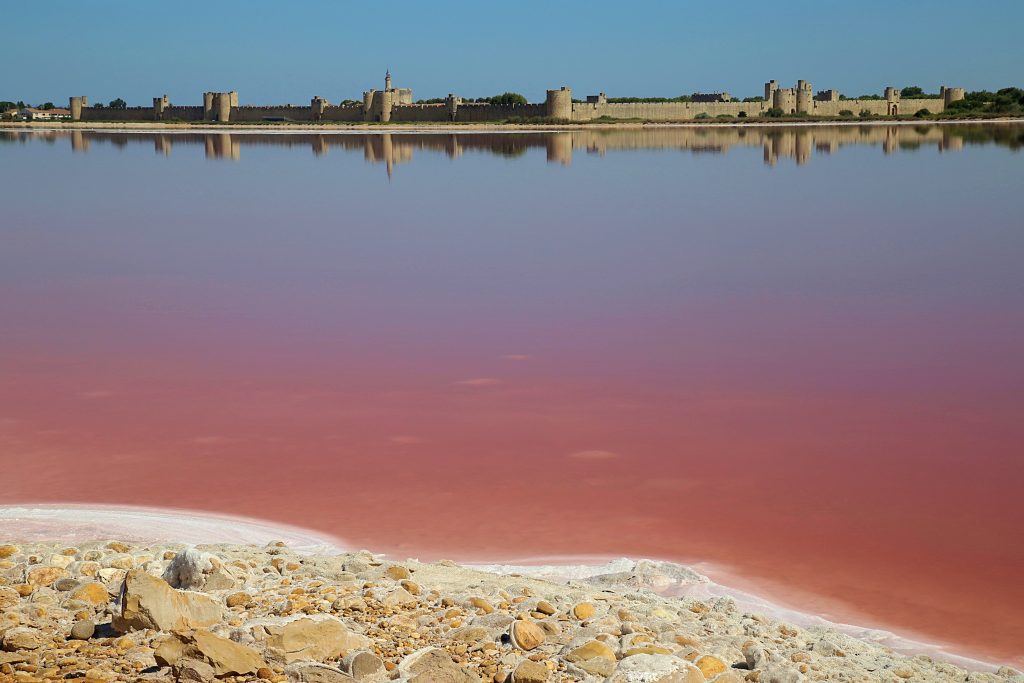
‘We are probably the first generation since the beginning of the world to be paranoid about salt’. We would all die without salt. It is the only mineral we eat straight out of the ground’, says Jeffrey Steingarten of the New York Times, writing in his book ‘The man who ate everything’.
He was the first writer, that I read, to deflate the low salt myth: ‘Growing up in a hysterical anti-salt environment, a whole generation of American future home-makers lack the slightest notion of how to cook with it and how the various types of salt taste and behave’.
In the early 1980s, I remember wandering through the aisles of American supermarkets with cans of food boasting ‘low sodium’. Since then I’ve encountered so many people who never salt their cooking. My daughter’s fellow students at university didn’t even salt their pasta water. This insanity was based on unreliable extrapolations of certain scientific experiments.
American doctor James Dinicolantonio has written a book ‘The Salt Fix’ explaining how most people don’t eat enough salt. He references numerous scientific studies that show that a low salt diet is dangerous for your heart, encourages obesity, is dehydrating, raises cholesterol and insulin, and crucially makes no difference to your blood pressure.
On the other side is a lobby headed by British doctor Graham McGregor who obsessively campaigns against salt, exhorting the NHS to invest millions in salt avoidant advice. The official salt guidelines are so low – 1.5mg or quarter of a teaspoon – this isn’t just salt at the table but all salt over a 24 hour period – they are impossible to maintain. Add to this that some of the most common medicines make things worse by draining your body of salt and you have a situation where people have a salt deficit.
It is estimated that between 8 and 20% of people have a salt sensitivity and must be careful about how much salt they eat. The rest of us can eat as much as we like! That’s what our kidneys are for – you literally piss out any excess. Extra salt is also held in the skin – lick your arm- it’s salty. The body is adapted to deal with salt excess – it shunts it into the kidney, the organs, even bones. The body cannot deal with a lack of salt.
How do you know if you have a salt sensitivity? At present there is no test for this, although medical researchers are trying to discover one. The only current method of finding out is by going on a two week medically supervised diet: the first week eating no salt and the second week with salted foods. Doctors check whether your blood pressure has risen.
Visit to La Baleine
Earlier this summer I visited the salt flats of La Baleine, which is in the Camargue, near to the 13th century fortressed settlement of Aigues-Mortes.
One of the oldest breeds of wild horses, the white horses of the Camargue performed dressage within a salt circle with the blue Mediteranean sea in the background. The riders or gardians wore the traditional cowboy outfit of the area: the men in suede chaps, fringed waistcoats and hats, the women in shawls, thick skirts and white caps.
The evening of our arrival, we dressed in white for a ‘diner en blanc’ on a salt mountain or ‘camelle’ (a camel’s hump), the largest in Europe, which tinted pink as the sun dipped under the horizon. The next day I took a tour of the salt pans. These salt basins are flooded and drained with a series of taps, allowing the salt to dry. The furthest basin away from the sea contains the finest quality of sea salt ‘fleur de sel’.
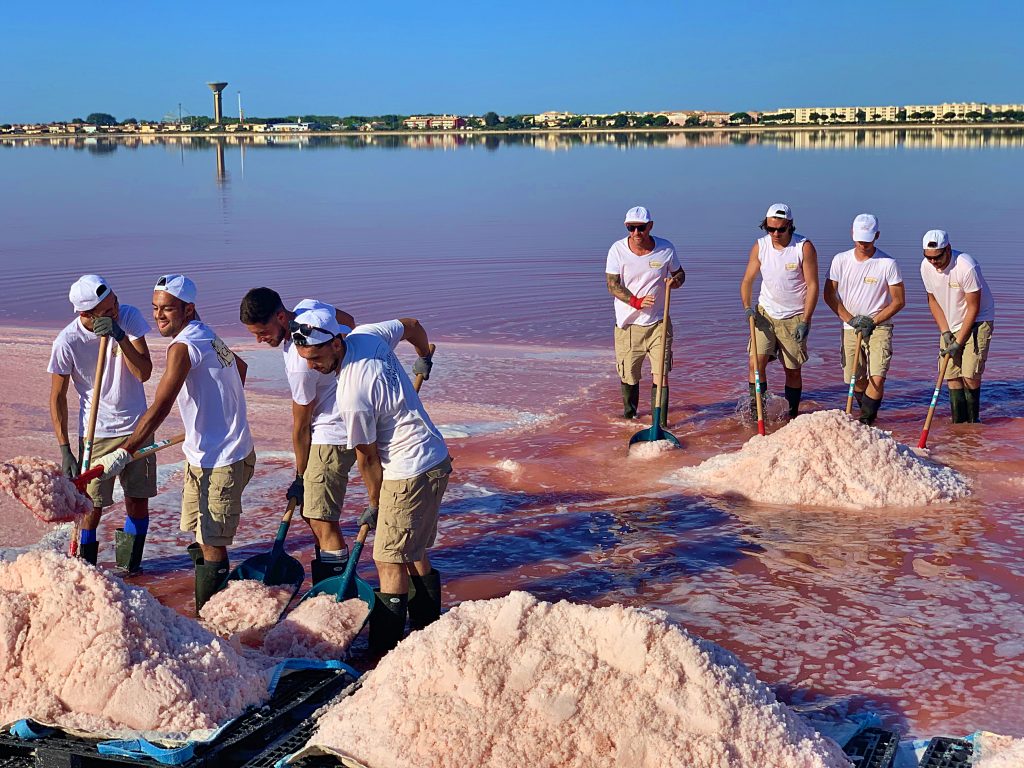
Hand-harvested by locals, a job passed down through families, it’s a short season and hard work in the blistering heat of the south. I asked why there were only men.
“C’mon have a try!” taunted the men.
I took a large blue shovel with a wooden slat underneath and drove the pinkish salt towards the edge. The men, called ‘Sauniers’ or ‘Palludiers’, with the red shovels lift up the salt and pile it up at the side where it will dry in the sun. Within ten minutes I could see why it was a male job. The fleur de sel is skimmed by hand off the top. I collected two large bagfuls of the pale rosy salt.
The water in the salt basins is millennial pink, caused by a particular algae, micro-organisms that thrive in high salinity, also known as halophiles or extremophiles. This area of the Camargue hosts flocks of pink flamingos. While baby flamingos are grey, turning white as they get older, only the oldest flamingos are pink – the more they eat the algae, the pinker they become.
Don’t lessen your salt intake, just make sure it comes from good sea salt. Improve the quality of your salt.
Salt FAQs
Salt is NaCl or Sodium Chloride: 40% sodium and 60% chloride.
Sea salt is 13% saltier than land salt, meaning you do not need to salt as much.
Sea salt contains 60%. more calcium, and three times more potassium and magnum than land salt.
The finest sea salt, la fleur de sel, (the flower of the salt), has a season of about six weeks from June to the end of July.
Types of salt
Rock salt from the land, which is mined. A pink version of this, Himalayan rock salt, is mostly mined in Pakistan.
Sea salt from the sea, evaporated in shallow salt pans.
Table salt
Fleur de sel: this salt has small fine grains and is used for ‘dressing’ your food. Sprinkle it on top for texture and taste. It contains more minerals and is said to taste of violets. Use sparingly, it’s expensive.
Fine salt: this is a fine grained white sea salt. This is good for everyday use.
Commercial table salt: this salt has the finest grains. It lacks minerals and flavour. It is usually fortified with iodine, to prevent goiters.
Cooking salt
I buy sel gris or grey salt from France. It’s damp, with big crystals and is perfect for salting cooking water and other purposes. Cheap in France, around a euro per kilo.
Kosher salt is popular in the USA. It’s finer than grey salt or rock salt.
Coarse sea salt: larger white crystals of sea salt, good for cooking.
Pickling salt is very fine grained, designed to melt quickly in liquid.
There are many flavoured and coloured salts: red clay ‘Alaea’ salt from Hawaii, bamboo salt from Korea (where they eat huge quantities of salt and have one of the lowest proportions of hyper-tension and heart disease), black salt ‘kala nemak’ from India, a sulphuric tasting salt.
Salt Tourism
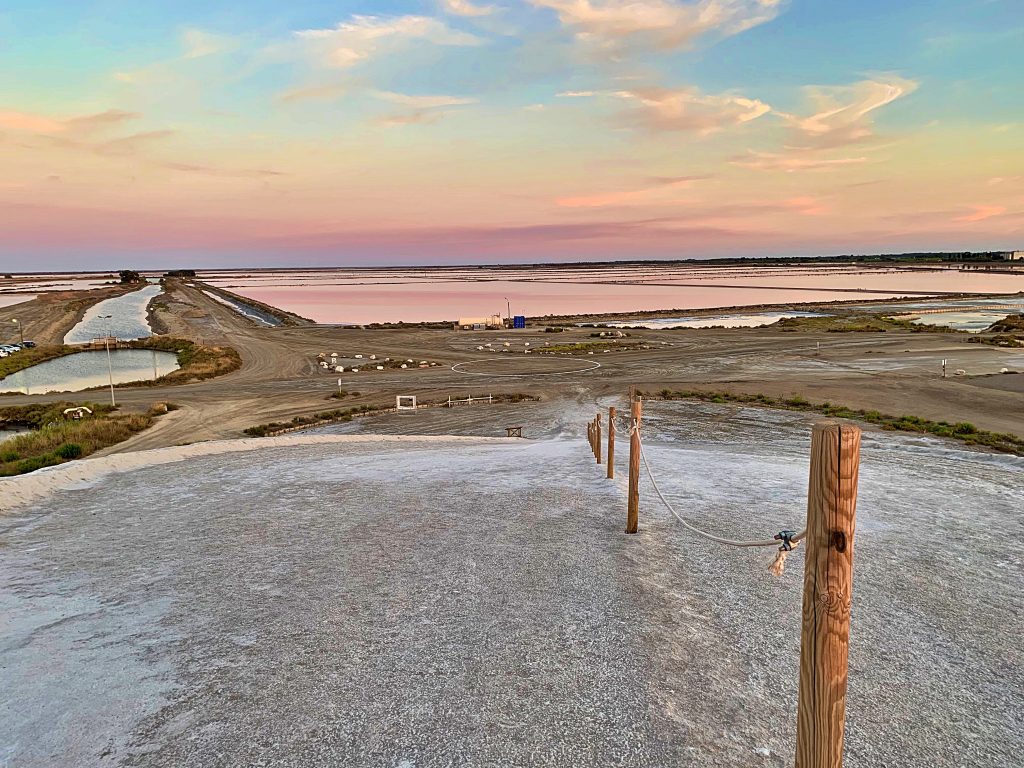
Visit le Salin d’Aiguës Mortes from April till November. This can be a guided or unguided tour, with your own bike, with a rental bike, on foot or with the little train. Prices range from 29 euros per person to 10 euros. There is a salt shop (where you can buy different flavoured salts) and museum.
The private and wild beach, Plage du Salin, where we had lunch is available for tourists: prices range between 30 and 80 euros per person.
Other places to do salt tourism:
The salt cathedral in Zipaquira, Colombia
The salt flats in L’ile de Ré, France (La Baleine’s sel gris grey cooking salt comes from the Atlantic coast)
The Piran salt flats of Slovenia
Salt recipes
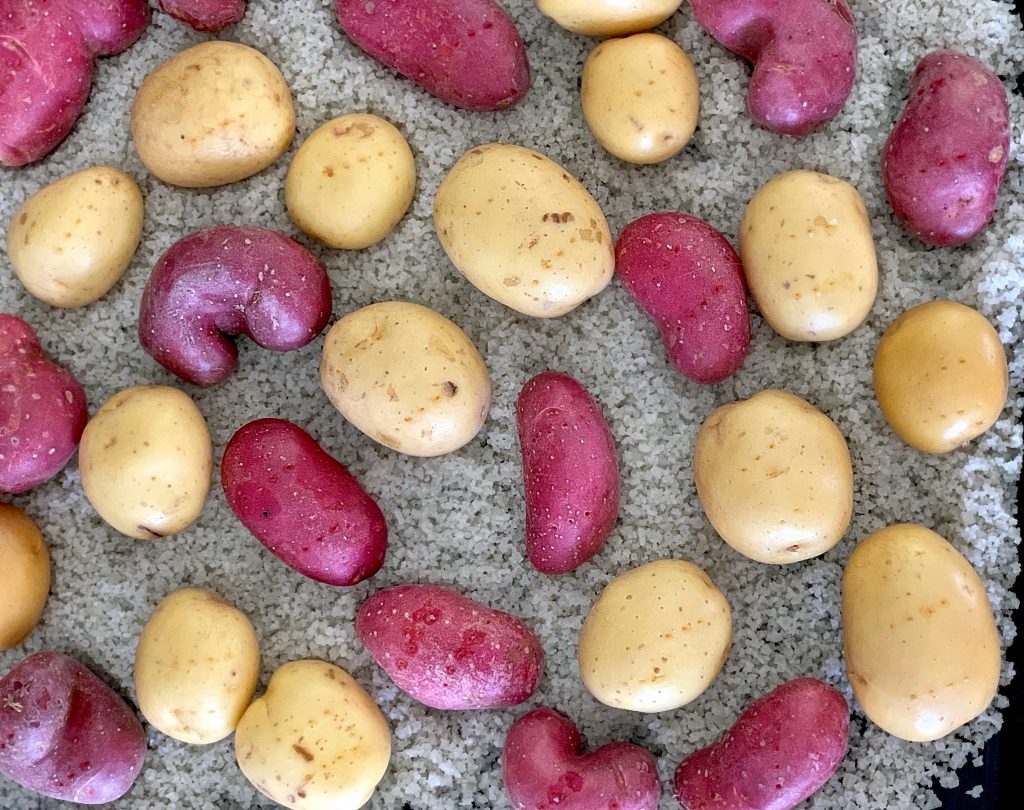
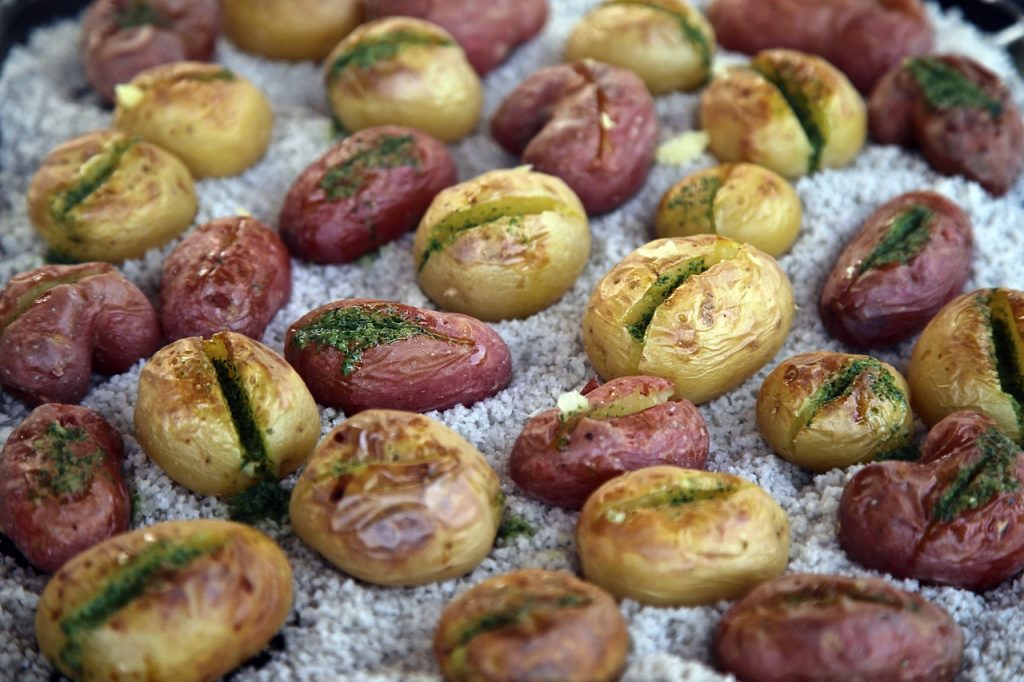
Salt encrusted potatoes
Ingredients
- 1 kilo coarse sea salt (in France use sel gris) or rock salt
- 20 small to medium potatoes, skins on, washed, For presentation I used white and red skinned potatoes. Feel free to use purple/red/white potatoes when in season.
- 100 g garlic/parsley butter, or butter and creme fraiche or yoghurt and extra salt
Instructions
- Preheat the oven to 200cº
- Spread a kilo of the salt over the bottom of a clean dry oven dish
- Place the washed dried potatoes on the bed of salt. Prick each potato with a fork.
- Cook for 45 minutes.
- Remove from the oven and cut a slash in each potato, adding in the topping of your choice.
- Serve hot, allowing people to pick the potatoes off the bed of salt.
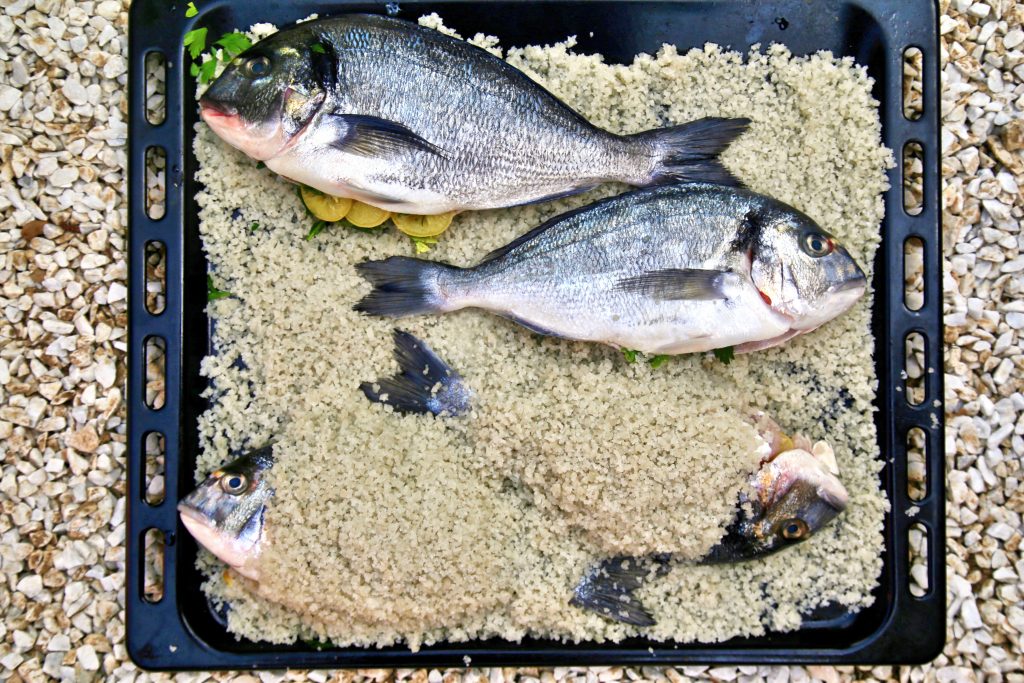
Fish in salt crust stuffed with preserved lemons
Ingredients
- 3 to 4 kilos coarse sea salt, sel gris, kosher salt, rock salt
- 4 or 5 egg whites
- 4 500 to 600g entire fish, cleaned and gutted
- 4 Preserved salted lemons, sliced
- handful parsley, chopped
Instructions
- Preheat the oven to 220ºc (428ºF)
- In a large bowl, empty the sea salt and mix with the egg whites
- Stuff the empty stomachs of the fish with the sliced preserved lemons and parsley
- Add a layer of salt to the bottom of the dry oven dish
- Place the fish on top and cover each one with a mound of the sea salt mixture. You can leave heads and tails uncovered but make sure there are no holes in the mixture. The salt acts as an oven within an oven.
- Bake for 40 minutes or until the digital temperature guage says 65ºc (149ºF) in the centre of the fish. Or use a metal skewer and touch under your bottom lip with it. If it feels hot it's done.
- Serve whole on the tray. Crack open the salt crust. Often the skin will come off with the salt. Remove the salt on top to another plate. Serve the top layer of the fish. Remove the spine and serve the bottom half of the fish. Put a little of the preserved lemon stuffing on each plate with the fish.
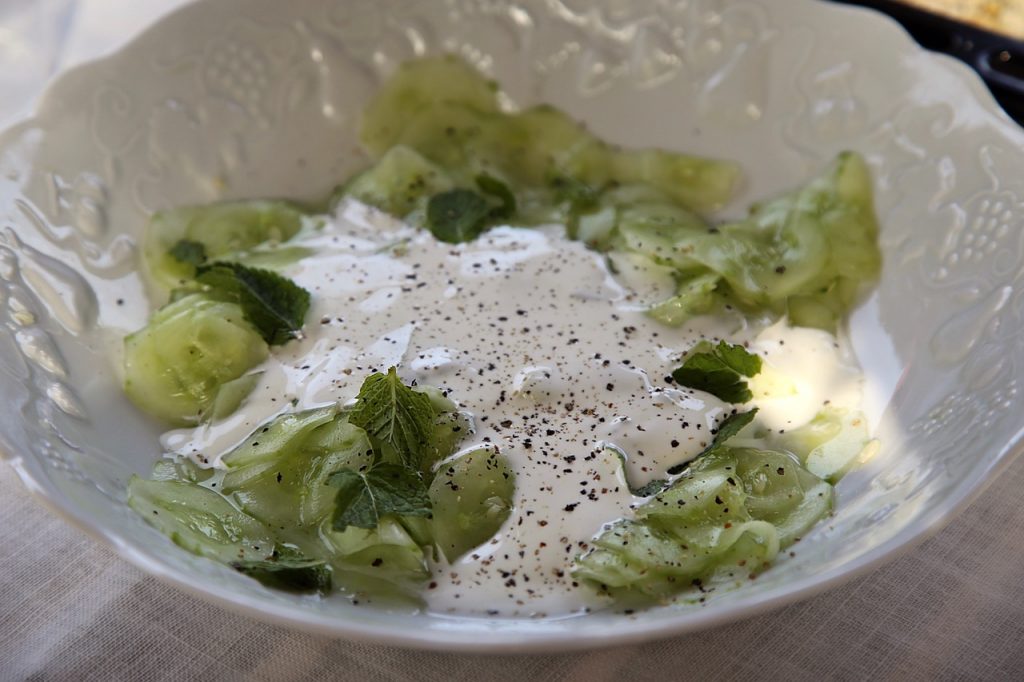
Cucumber salad
Ingredients
- 2 cucumbers, peeled and sliced as thinly as possible
- 3 to 5 tbsp fine sea salt
- large scoop creme fraiche or Greek yoghurt
- Sprigs fresh mint
- white pepper
Instructions
- Put the cucumber slices into a bowl with the salt. Cover and rest overnight in the fridge.
- The next day drain the water from the cucumber slices. If it's very salty then rinse and pat dry, with a clean unfluffy tea towel, the cucumber slices.
- Layer the cucumber slices in a wide bowl and put a big dollop of creme fraiche in the middle.
- Add the fresh mint and white pepper.
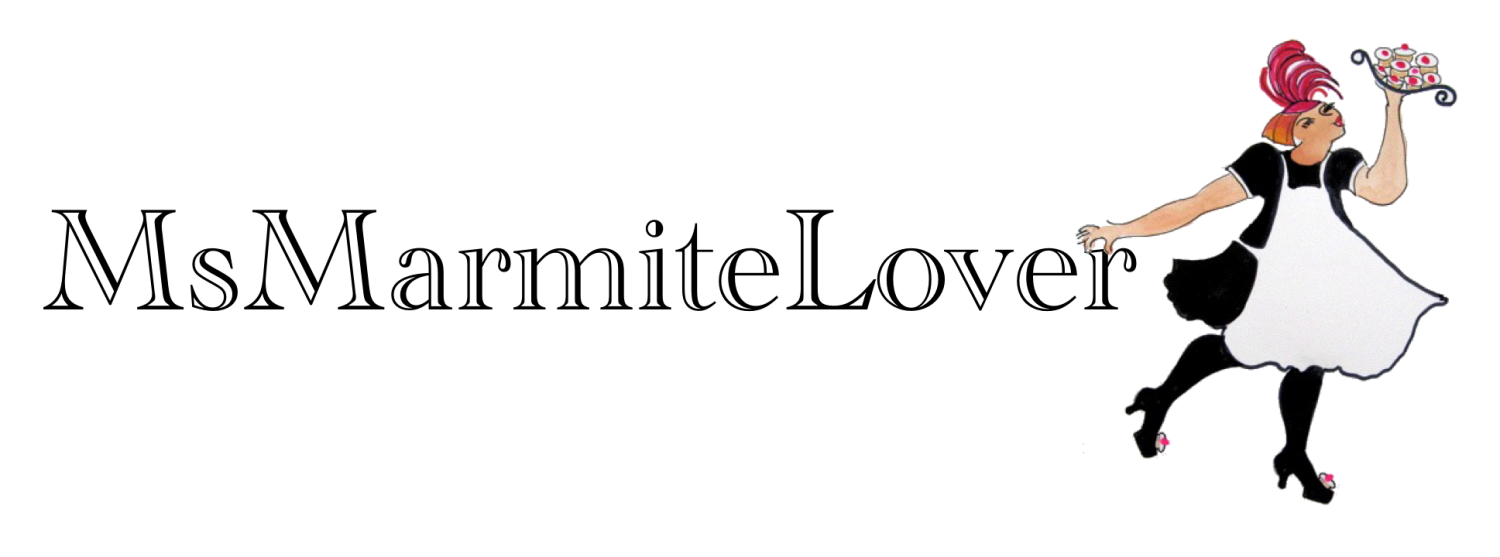
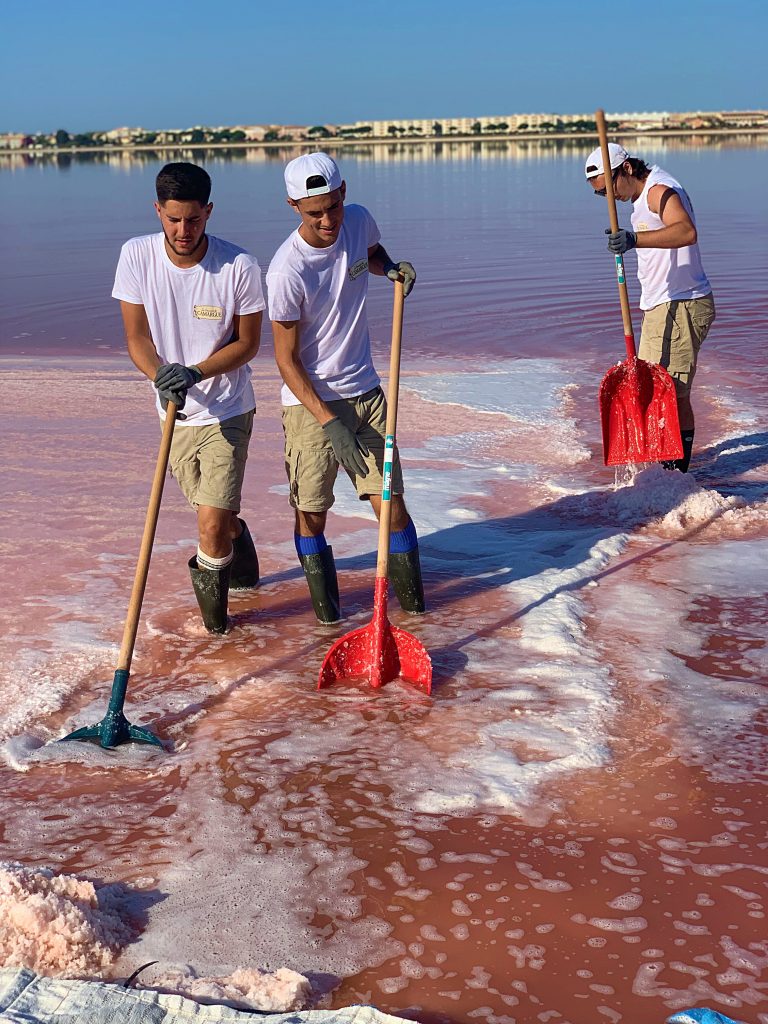
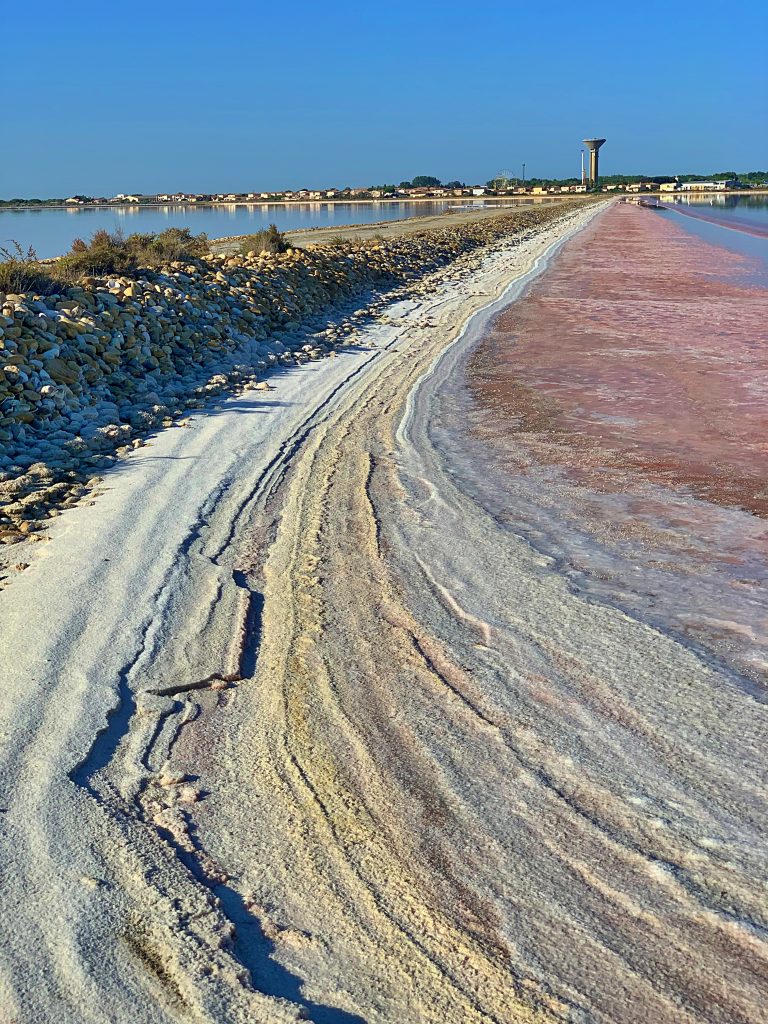








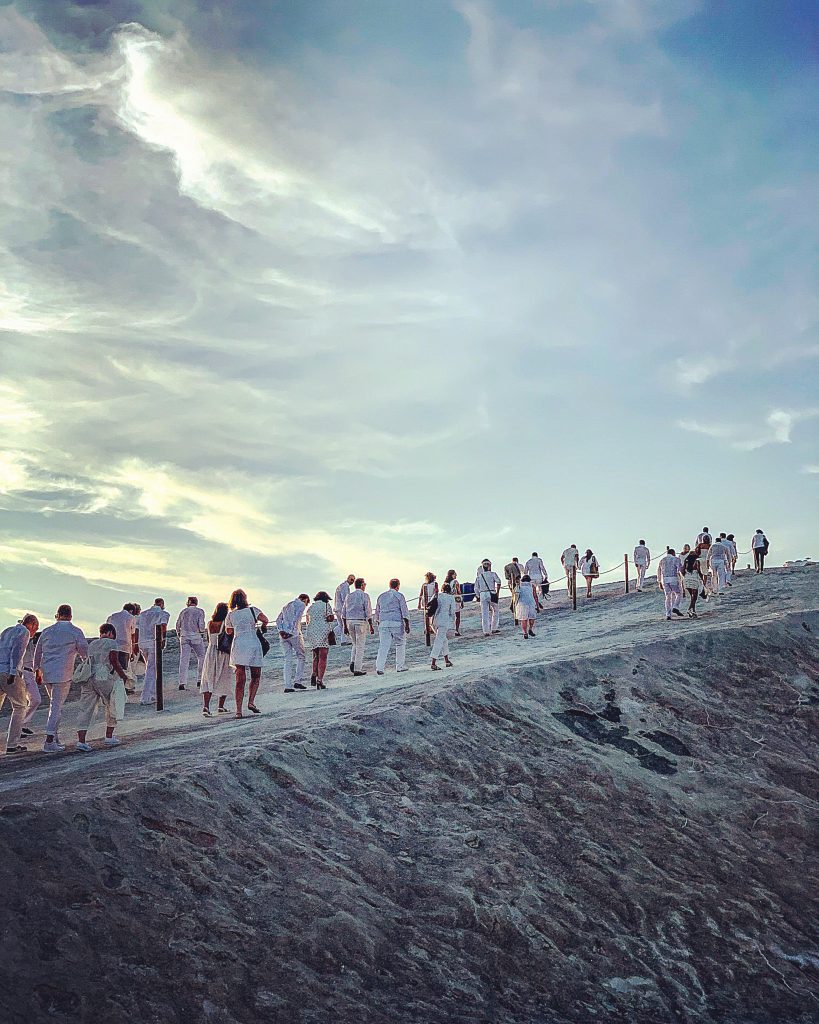

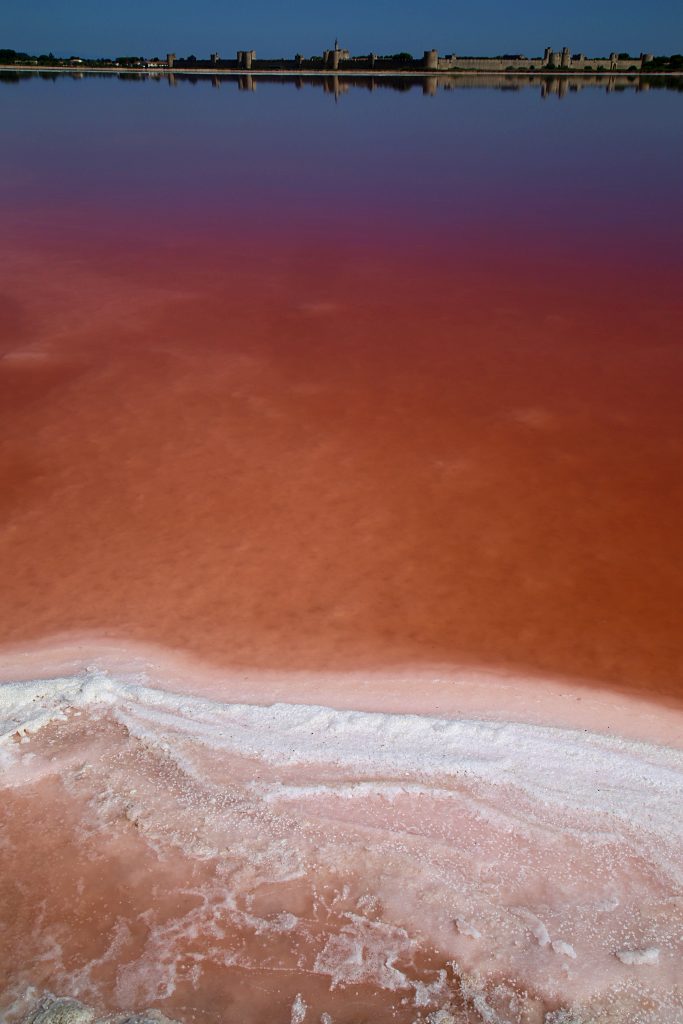
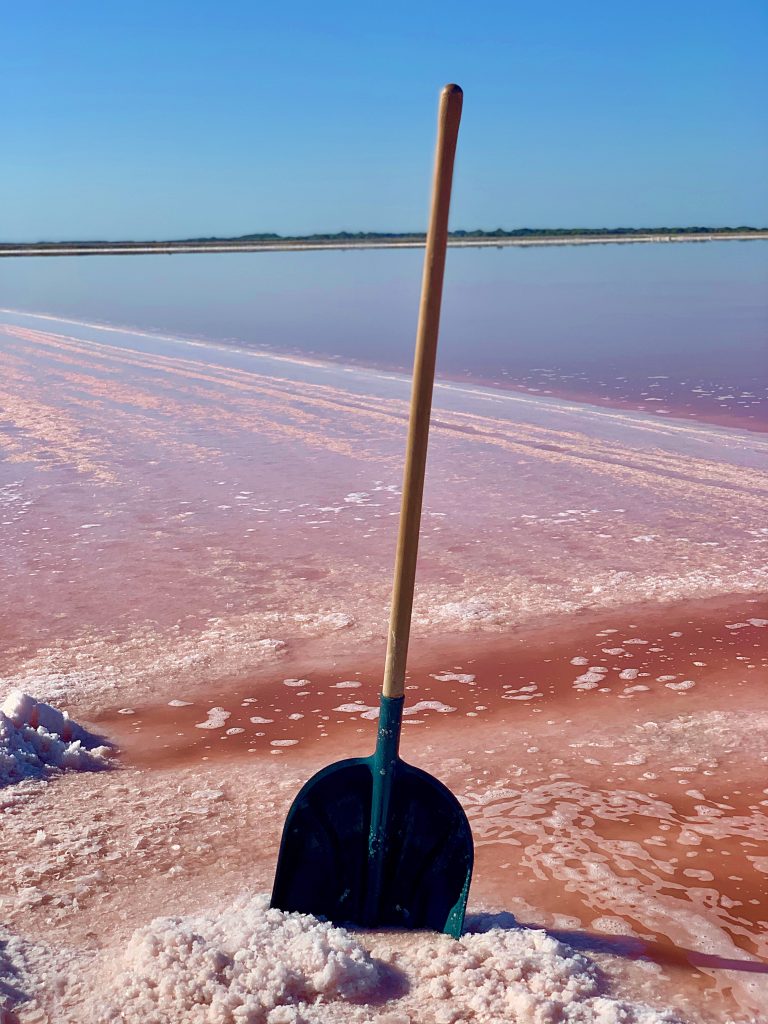
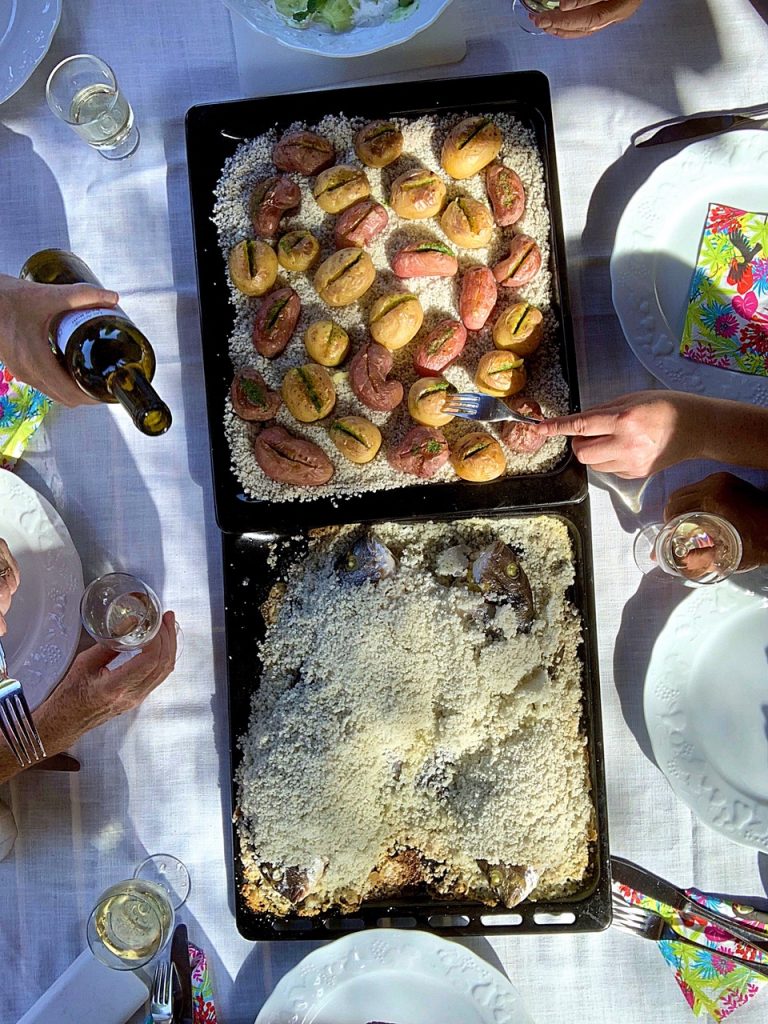
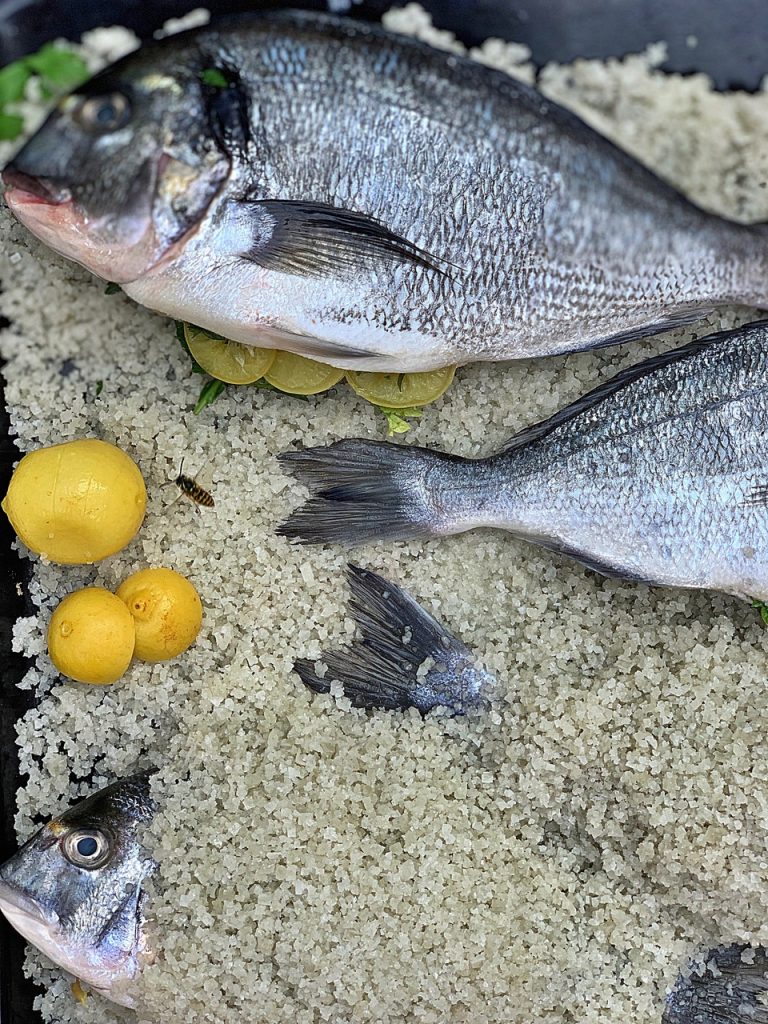



What a magical experience! The salt looks beautiful- I couldn’t be happy with anyone on a low salt diet- where would the flavour go? I use lots of Murray River salt which has a similar pinkish hue. And those potatoes are calling my name tomorrow!
this is so amazing, and the amount of the salt
Does anyone know if LA Baleine course sea salt is high/low for heavy metals etc.? Thank you! 🙂
I’m not sure but it’s straight from the sea so it’s probably the same as any sea salt.